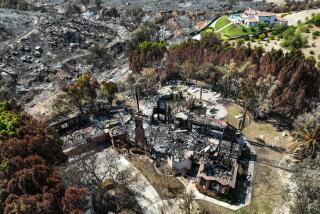A Fortune Built From Elbow Grease and Oil
Margaret Frances Slusher didn’t marry her money, she made it -- parlaying a bootstrap fortune from her laundry business into an oil empire.
Slusher was a simple, animal-loving Californian who lived a quiet but comfortable life in numerous houses across Los Angeles County. Her address book included Ronald Reagan and Howard Hughes.
For the record:
12:00 a.m. June 17, 2006 For The Record
Los Angeles Times Saturday June 17, 2006 Home Edition Main News Part A Page 2 National Desk 1 inches; 37 words Type of Material: Correction
Margaret Frances Slusher: The L.A. Then and Now column in Sunday’s California section said Margaret Frances Slusher’s apartment buildings on Rossmore Avenue were near the Los Angeles Country Club. They were closer to the Wilshire Country Club.
For The Record
Los Angeles Times Sunday June 18, 2006 Home Edition Main News Part A Page 2 National Desk 1 inches; 39 words Type of Material: Correction
Margaret Frances Slusher: The L.A. Then and Now column in the June 11 California section said Margaret Frances Slusher’s apartment buildings on Rossmore Avenue were near the Los Angeles Country Club. They were closer to the Wilshire Country Club.
But her renown had faded until a gumshoe developer uncovered a buried Spanish hacienda in Topanga Canyon. In the process, he and a former Slusher neighbor revived the story of the laundress turned wildcatter.
Born Margaret Frances Campbell in May 1879, she and her parents moved from San Francisco to Los Angeles when she was 6. By chance, they arrived during the smallpox epidemic of 1886. She survived; they didn’t. She grew up in a Catholic orphanage downtown.
“I was a bad child, but I was smart,” she said, her blue eyes twinkling merrily, as she described her life in a 1922 Times interview. “I had the spirit of the wind in me -- always inquisitive and restless and anxious to go.”
As a young woman, she took in laundry to support herself. By the coolness of night, she sweated over boiling vats of soap and lye. During the heat of day, she delivered clean laundry and tried to drum up more business.
In 1901, when she was 21, she founded the New Method Laundry, which cleaned with newfangled steam, at 6th and San Julian streets. Her advertising slogan, “Run by a Woman,” had a nice ring -- and it wasn’t around the collar.
At the time, most laundries were run by men who cleaned with soap, water and elbow grease.
Male-run laundries lured away a few of her workers with empty or short-term promises, including free lunches. Laundrymen, jealous that she had a big chunk of the business, accused her of running a sweatshop and violating the Child Labor Act.
She defended herself through speeches to powerful women’s clubs, which generated more business. The men accused her of using the clubs for a “sympathetic ear.”
In 1901, laundry workers struck citywide for better wages, overtime and paid holidays. When the strike ended later that year, she was famous for hard-nosed bargaining as well as for white collars.
In 1902, she married railroad fireman Silas Floyd Slusher, 26, from Virginia. How they met is unclear, but it could have been at the Oddfellows Lodge, where they both were members.
In 1907, she sold her shop on San Julian Street and built a three-story brick building on Paloma Street, in what is now the Garment District, for $13,500 -- about $300,000 in today’s economy.
She changed the name to Quality Laundry and expanded, hiring more than 70 workers and taking on $100,000 in debt. The experience nearly derailed her business career, but she persevered and prospered. “A Los Angeles Woman Refused to Quit and Wrestled Fortune From Near Bankruptcy,” a Times headline said in 1922.
In 1916, with a borrowed $5,000 down payment, the Slushers bought a 45-acre vacation property and citrus ranch in Santa Fe Springs for $30,000. The site had been part of a 300,000-acre Spanish land grant in 1784. Part of their retreat is included in the six-acre Heritage Park, which includes a re-creation of the citrus ranch and the carriage barn, as well as Slusher’s original aviary.
Four years later, she sold her laundry business at a hefty profit for $150,000. She threw a farewell party for 50 employees at her ranch, giving each a week’s salary and a diamond pin. That year, she leased most of her ranchland to Shell Oil Co.
A driller smitten with her -- or maybe with the diamond her husband had given her -- said: “If I bring you in a 5,000-barrel well, will you give me that ring?”
“I have to ask my husband,” she said, The Times reported.
When Shell’s Slusher No. 1 promptly came in at 8,000 barrels a day, she and her husband gave each driller a large diamond ring and matching pin.
By 1924, there were 12 wells on the Slushers’ ranch, bringing in a total of $30,000 to $60,000 a month, The Times reported.
She gave people expensive gifts for the slightest favor. Mary Hathaway, who now lives in California’s Central Valley, grew up next door on a ranch in Santa Fe Springs. “She gave me a diamond ring for raking her leaves” in the late 1950s, Hathaway recalled in a recent interview. “She always wore black dresses and black hats, and her chauffeur, Arthur, drove her around in a black Cadillac, just like in ‘Driving Miss Daisy.’ ”
Aside from the miniature oil derricks that adorned the hoods of her cars, her tastes remained simple. When she went to Europe, it was to sightsee, not shop. “Just to travel and to see the people and customs of other countries,” she told The Times in 1924. “I’ll buy my clothes in America. When you buy French things, you pay for the foreign labels ... and I know all about labels. Don’t forget, I was in the cleaning business.”
During the Depression, she discovered other passions: animals, horse racing and construction. She built homes in Topanga Canyon and Beverly Hills and apartments on Rossmore Avenue, near the Los Angeles Country Club. Reagan moved into one of the apartments, her neighbor remembered.
Slusher’s gushers, which produced oil for more than two decades, helped fill her address book with A-listers, including Reagan, Hughes, Jack Benny, Edgar Bergen, Ingrid Bergman, James Cagney, Leo Carrillo, Bob Hope, Lena Horne, Hedda Hopper and Nat King Cole.
Then, in the 1930s, she disappeared from the newspapers.
*
In 2004, Mark Friendship bought 3.6 acres along the creek in Topanga Canyon. Hidden behind 75 years’ growth of foliage, he discovered a house -- Slusher’s.
“It was as if someone just locked the door behind them and didn’t come back,” he said in a recent interview. “It was amazing. Dishes, an old radio and Slusher’s original gold velvet drapes were still on the windows.”
Slusher, who stopped going there in the late 1940s after her husband died, had sold it in 1960.
Friendship restored the hacienda and outbuildings, including a stone chapel, to 1930s glory.
Last year, Pete Dupuy, 70, a commercial fisherman who lives in Tarzana, visited the property and helped Friendship connect most of the dots.
Dupuy remembers when the place was known simply as Silas’ Cabin, back in the 1930s and ‘40s.
“I lived next door with my mother,” Dupuy said in a recent interview. “When I needed straightening out, my mother sent me to stay with the Slushers. She was a great lady, like an adopted mother, whose philosophy was always, ‘Work hard and you come out on top.’ ”
Slusher knew Dupuy’s grandfather, Sylvester Dupuy, a farmer and sheep rancher who built the landmark “Pyrenees Castle” in Alhambra, modeled after his boyhood home in France.
The Alhambra mansion was bought by rock ‘n’ roll producer Phil Spector in 1998. It was there that, in 2003, he allegedly shot and killed actress Lana Clarkson. He has pleaded not guilty to murder charges and awaits trial.
After her Santa Fe Springs mansion burned down in 1941, Slusher used a tiny wooden house on the ranch. She called it “Maggie’s Shack.”
She died in 1971, at age 92, leaving the bulk of her estate to the Society for the Prevention of Cruelty to Animals and the Shriners Hospitals for Children. Dupuy has her address book.
The Santa Fe Springs land was zoned for industrial development when the city purchased it in 1984. But, as the property’s history became known, the idea of a park took shape.
“When Shell Oil started drilling in the Middle East, they capped her wells sometime after the war,” Dupuy said. “I know there’s still lots of oil down there, and so did she.”
More to Read
Inside the business of entertainment
The Wide Shot brings you news, analysis and insights on everything from streaming wars to production — and what it all means for the future.
You may occasionally receive promotional content from the Los Angeles Times.






